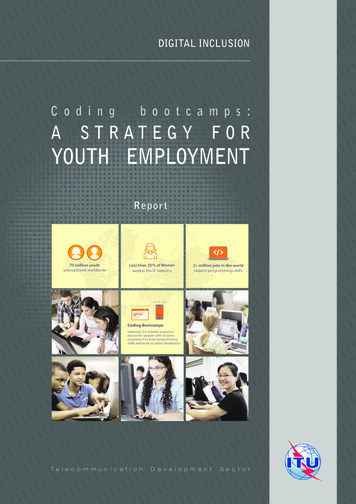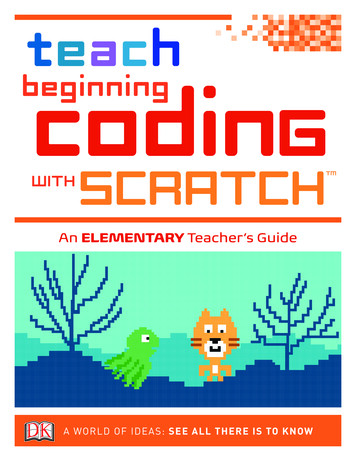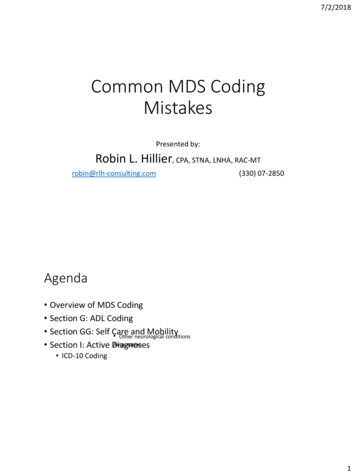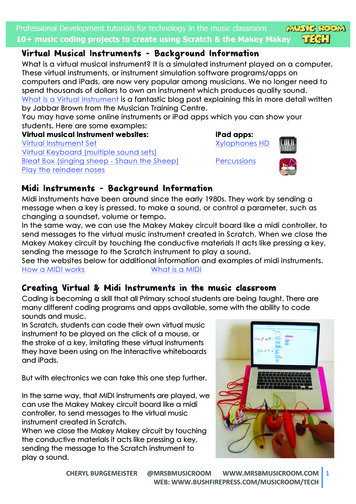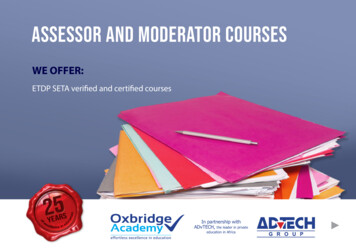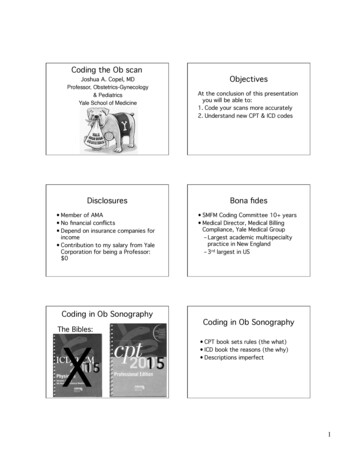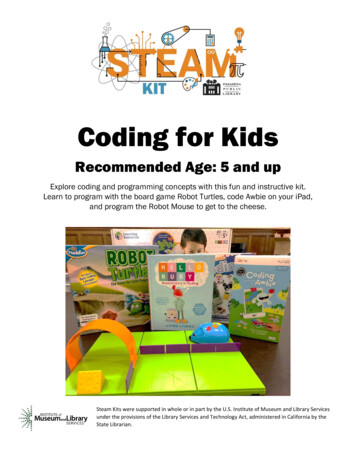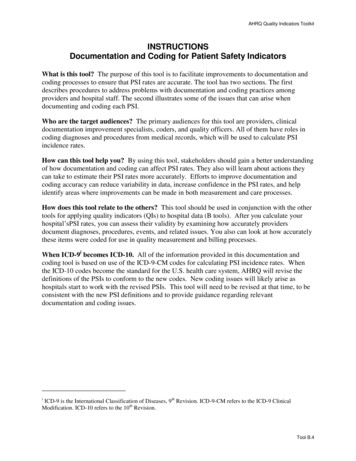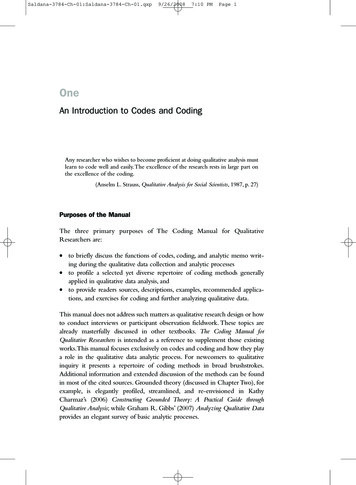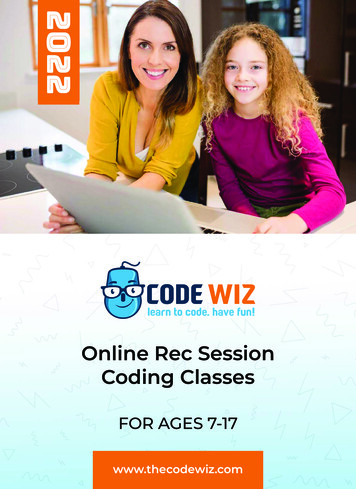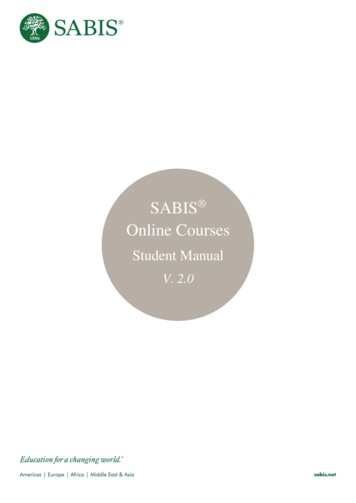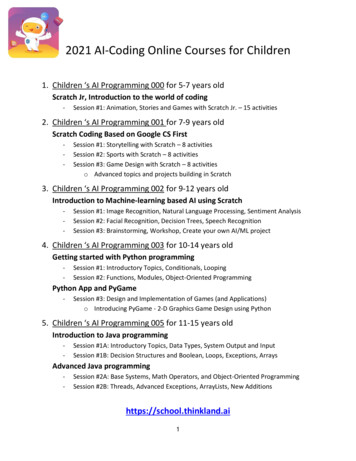
Transcription
2021 AI-Coding Online Courses for Children1. Children ‘s AI Programming 000 for 5-7 years oldScratch Jr, Introduction to the world of coding-Session #1: Animation, Stories and Games with Scratch Jr. – 15 activities2. Children ‘s AI Programming 001 for 7-9 years oldScratch Coding Based on Google CS First-Session #1: Storytelling with Scratch – 8 activitiesSession #2: Sports with Scratch – 8 activitiesSession #3: Game Design with Scratch – 8 activitieso Advanced topics and projects building in Scratch3. Children ‘s AI Programming 002 for 9-12 years oldIntroduction to Machine-learning based AI using Scratch-Session #1: Image Recognition, Natural Language Processing, Sentiment AnalysisSession #2: Facial Recognition, Decision Trees, Speech RecognitionSession #3: Brainstorming, Workshop, Create your own AI/ML project4. Children ‘s AI Programming 003 for 10-14 years oldGetting started with Python programming-Session #1: Introductory Topics, Conditionals, LoopingSession #2: Functions, Modules, Object-Oriented ProgrammingPython App and PyGame-Session #3: Design and Implementation of Games (and Applications)o Introducing PyGame - 2-D Graphics Game Design using Python5. Children ‘s AI Programming 005 for 11-15 years oldIntroduction to Java programming-Session #1A: Introductory Topics, Data Types, System Output and InputSession #1B: Decision Structures and Boolean, Loops, Exceptions, ArraysAdvanced Java programming-Session #2A: Base Systems, Math Operators, and Object-Oriented ProgrammingSession #2B: Threads, Advanced Exceptions, ArrayLists, New Additionshttps://school.thinkland.ai1
OverviewCourse IDCourse NameCourse LevelAI000Scratch JrSession #1AI001ScratchSession #1Session #2Session #3AI002Scratch AISession #1Session #2Session #3AI003PythonSession #1Session #2Session #3AI005JavaSession #1Session #2* Each session is 16 hours of classClass Selection Guideline2Session #4Session #4
Children ‘s AI Programming 000Scratch Jr., Introduction to the world of codingAI000 Scratch Jr. COURSE OVERVIEW:Scratch Jr is an introductory programming language that encourages creativity and expression,enabling five- to seven-year-old children to create their own interactive projects through coding.It provides young children with opportunities to design, create, and express themselves. UsingScratch Jr, children can use the programming blocks to bring their characters to life. Getting Started:Students will learn the basics of using Scratch Jr. and make a dance party! Animations – 4 activities:Students will create four small activities together, and then put all together to make afinal animation. Stories – 6 activities:Students will make their own stories by adding dialogue and new scenes to theanimations. To make these stories come to life and play out like a movie! Games – 5 activities:Students will learn how to make games. To make four different small games, and thenuse everything together to make one big game at the end.3
Children ‘s AI Programming 001Scratch 3.0 Coding Based on Google CS FirstAI001 Scratch COURSE OVERVIEW:Extending from Google’s CS First themed curriculum, we introduce grades 2-5 students (7years-old and up) to coding principles, all in project-based activities. Kids will systematicallylearn to program in Scratch, meanwhile explore storytelling techniques, build fun games andcraft interesting presentations. The projects will showcase their creativity with the aid of codingand digital designs. Session 1 (Storytelling with Scratch – 8 activities):Students use code to tell fun and interactive stories. Storytelling emphasizes creativityby encouraging students to tell a unique story each day. Session 2 (Sports with Scratch -- 8 activities):Students use computer science to simulate extreme sports, make their owncommercials, and create commentary for a sporting event. Session 3 (Game Design with Scratch – 8 activities):Students learn basic video game coding concepts by making different types of games,including racing, platform, and launching.4
Children ‘s AI Programming 001 Curriculum in DetailScratch 3.0 Coding Based on Google CS FirstAI001 Session#1: STORYTELLING (16 hours)1. Dialogue: Learn about CS First and Scratch, then create a story in which two characterstalk without using questions.2. Check It Out: Tell a story in Scratch. In the story, a character walks through a scenedescribing what they see.3. Setting: Create a dynamic stormy day setting, complete with rain and lightning.4. Premise: Build a story around one of four premises.5. Characterization: One character narrates another character's actions and thoughts.6. Interactive Storytelling: Create a story in which the audience can make a decision.7. Personal Narrative: Create a personal narrative based on one of three premises.8. Your Innovation Story: Create an innovative product or idea, then use storytelling topitch or sell it.5
AI001 Session#2: SPORTS (16 hours)1. Victory Celebration: Learn about CS First and Scratch, then create a victory celebrationin Scratch.2. Sports Commentary: Create a dance, cheerleading, karate, or basketball performancecompetition. Then write the commentary for each of the competitions.3. Net Sports: Create a fun net sport game with a bouncing ball and an athlete.4. Fitness Gadget Commercial: Create a commercial around one of four fitness gadgets:wrist wear, eyewear, headwear, footwear.5. All-Star Passing Drill: Build an all-star passing game where you try to aim at a movingreceiver.6. Batter Up: Build a home run derby style baseball game.7. Extreme Sports: Build an extreme sports game in which a racer navigates an obstaclecourse for as long as possible.8. Post-Game Interview: Build a project in which you get interviewed about what youprogrammed and learned in class.6
AI001 Session#3: GAME DESIGN (16 hours)1. Gaming Story: Learn about CS First and Scratch, then create a gaming story.2. Racing Game: Create a two-player racing game in which users control movement withthe keyboard.3. Maze Game: Create a game in which the user guides a sprite through a maze.4. Platform Game: Create and learn about platform games. Students program a playersprite to move and jump across platforms.5. Escape Game: Create an escape game in which a player must avoid other sprites thatmove randomly.6. Launcher Game: Create a launcher game using key press events, clones, and variables.7. Quest Game: Learn how to use storytelling in video game design while building an RPGstyle Quest Game.8. Cave Surfing Game: Create a game with a side scrolling background (similar to thepopular game Flappy Bird).7
Children ‘s AI Programming 002Introduction to Machine-learning based AI using ScratchAI002 Scratch AI Course OverviewHave you ever wondered how Alexa could always find an answer to your whimsical questions?We have and we figured that out, in Scratch. Using the proprietary AI platform built byThinkland.ai, we introduce grades 4-8 students to the concept of machine learning and itsapplications in real life. Learning with 10 projects from different AI focuses all implemented inScratch, the kids will explore the meanings of artificial intelligence in our daily life and theengineering principles behind these AI-based applications. Session 1:1.2.3.4.Introduction to Machine LearningImage Recognition & Spongebob and FriendsNatural Language Processing & Simple Smart HomeSentiment Analysis & Praises and Criticisms Session 2:5.6.7.8.Facial Recognition & FacelockDecision Trees & Flappy BirdDecision Trees & PacmanSpeech Speaker Recognition & Voice Lock Session 39. Brainstorming Ideas Workshop10. Create your own project & Implement Multiple Machine Learning Concepts8
Children ‘s AI Programming 002 in DetailIntroduction to Machine-learning based AI using ScratchAI002 Session#1 (16 hours)1. INTRODUCTION TO MACHINE LEARNINGa. Introduce concepts of Artificial Intelligence and Machine Learning, Strong AI vsWeak AI to students. Discuss what a machine learning model is. Also brieflydiscuss future topics. Includes a project that teaches computers the ability toidentify an apple from and orange.b. Project: Apple or Orange. Create a Machine Learning model that can allow thecomputer to identify an apple from and orange.2. IMAGE RECOGNITION & SPONGEBOB AND FRIENDSa. Discuss image recognition, including how it works, applications. Also create animage recognition model that helps the computer to identify images and createa scratch project that utilizes this model.b. Project: Spongebob and Friends. Help the computer send different images ofSpongeBob, Patrick and other characters to their home/destination using amachine learning model.3. NATURAL LANGUAGE PROCESSING AND SIMPLE SMART HOMEa. Discuss Natural Language Processing, how it works, as well as applications of it inthe real world. Create a project that utilizes the NLP learning model.b. Project: Smart Home (Simple Version). Create a project that allows the player totype commands of any variation to open and close home appliances.4. SENTIMENT ANALYSIS & PRAISES AND CRITICISMSa. Discuss sentiment analysis, how to teach the computer to recognize sentiments,as well as applications of this concept. Create a project that utilizes thecorresponding machine learning model.b. Project: Praises or Criticisms. In Scratch, create a program that reacts accordinglyto the user's comments; if the comment is positive or is a praise, the programwill react happily. If the comment is negative or a criticism, the program will besad.9
AI002 Session#2 (16 hours)5. FACIAL RECOGNITION & FACELOCKa. Discuss facial recognition, how a computer can recognize and identify a personthrough facial features, as well as applications. Create a project that utilizes thecorresponding machine learning model.b. Project: Facelock. Create a simulation of a phone that will unlock depending onthe user's face, similar to an iPhone X.6. DECISION TREES & FLAPPY BIRDa. Discuss decision trees, an machine learning algorithm, and how computers canuse this concept to make decisions. Create a flappy bird project that uses thismachine learning algorithm.b. Project: Flappy Bird. Create a flappy bird game through Scratch, in which thecomputer will learn and adapt a human player's strategy, and be able to playflappy bird by itself.7. DECISION TREES & PACMANa. Continue the discussion on decision trees and create another scratch programthat uses decision trees to allow the computer to play a game.b. Project: Pac-Man. Create a Pac-Man game through Scratch, in which thecomputer will learn from the human player to play a simplified version of PacMan.8. SPEECH SPEAKER RECOGNITION & VOICE LOCKa. Discuss speech and speaker recognition, their differences, and their applications.Further discuss the idea of two factor authentication. Create a scratch projectthat utilizes both machine learning concepts.b. Project: Voice Lock. Create a simulation of a phone in which it can be unlocked ifthe speaker's voice matches the owner's voice. Further enhance the project byimplementing two factor authentications, which forces the user to say arandomized specific phrase in order to bypass the security.10
AI002 Session#3 (16 hours)9. Brainstorming Ideas Workshop10. Create your own project & Implement Multiple Machine Learning Concepts11
Children ‘s AI Programming 003Getting started with Python programmingAI003 Python Course Overview:An introductory course for those interested in learning Python, programming, and how to useprogramming in various mathematical and scientific tasks. Students will install Python 3.8, learnthe basics of Python programming, and apply the basics to various tasks. And then graduallyexpand to computational thinking skills behind software application design.Introduction to PythonSession 1:1.2.3.4.Introductory TopicsConditionalsLoopingFun projects!Session 2:5. Functions6. Modules7. Object-Oriented ProgrammingPython App and PyGameSession 3:8. Part I : Python Review9. Part II : Design and Implementation of Games (and Applications)10. Part III : Introducing PyGame - 2-D Graphics Game Design using Python12
Children ‘s AI Programming 003 in DetailGetting started with Python programmingAI003 Session#1 (16 hours)1. Introductory Topics Basics of Numbers Basics of Strings Taking input/output Variables, arrays, and tuples Program Flow2. Conditionals Booleans and comparators If-elif-else statements And/or/not Nesting3. Looping While loops For loops For loops v2 Break, continue4. Fun projects! Drawing with turtle Statistics with numpy AI003 Session#2 (16 hours)5. Functions Desc: Of the math kind and not of the math kind.6. Modules Desc: Building projects in pieces.7. Object-Oriented Programming Desc: Classic.13
AI003 Python App and PyGame:AI003 Session#3 (16 hours)This session aims to reinforce the python basics in a project based curriculum while graduallyexpanding to introduce computational thinking skills behind software application design. Someprevious basics will be reviewed, reintroduced and reinforced, and new topics will be introducedalong the way. The project based approach employs a pedagogical sequence: project demo - requirements analysis - problem presentation - solution proposal and implementation - reinforcement of syntax and coding concepts.Part I - Python ReviewThis part aims to review the basics of Python that may have been taught in the prior sessions.1. Project 1 - Guess the Number (1 - 1.5 hour)oTopics: import randint() for Blocks str(), int(), float() Booleans Comparison Conditional2. Project 2 - A Joke-Telling Program (1 hour) Topics: Escape ' and " print()3. Project 3 - Dragon Realm (1 - 2 hour) Topics: functions Multiline strings while Boolean operators return variablescope Parameters and arguments sleep()Part II - Design and Implementation of Games (and Applications)This part uses projects of increasing complexity to illustrate the computational thinking behindthe design and implementation (including testing) of software applications while reinforcingpreviously acquired Python basics.1. Interlude - Using the Debugger (1 hour) Topics: 3 types of errors debugger Go and Quit Stepping into, over, and out Breakpoints2. Project 4a - Designing Hangman with Flowcharts (1.5 - 2 hour) Topics: ASCII art Designing with flowcharts3. Project 4b - Writing the Hangman Code (2 - 3 hours) Topics: Lists in operator Methods split(), lower(), upper(), startswith(), andendswith() elif4. Project 4c - Extending Hangman (2 hours) Topics: dict Key-value pairs keys() and values() multi-var assignment5. Project 5 - Tic-Tac-Toe (3 - 4 hours) Topics: AI List references Short-circuit None6. Project 6 - The Bagels Deduction Game (2 – 3 hours) Topics: random.shuffle() Augmented assignment operators sort() join() String interpolation conversion specifier %s Nested loops7. Interlude - The Cartesian Coordinate System (1 hour)14
Topics: x-axis and y-axis Negative numbers Pixels commutativity abs()8. Project 7 - Sonar Treasure Hunt (4 hours) Topics: Data structures Pythagorean theorem remove() isdigit() sys.exit()9. Project 8 - Caesar Cipher (2 – 3 hours) Topics: Cryptography and ciphers Ciphertext, plaintext, keys, symbols Encrypt/decrypt Caesar cipher find() Cryptanalysis The brute-force10. Project 9a - The Reversegam Game (4 – 5 hours) Topics: bool() Simulating moves on a Reversegam board11. Project 9b - Reversegam AI Simulation (2 – 3 hours) Topics: Simulations Integer division round() Computer-versus-computergamesPart III - Introducing PyGame - 2-D Graphics Game Design using PythonThis part introduces the basics of a popular Python library (pygame) as a bridge to the conceptscommon in computer game development while further developing the students’ softwaredevelopment skills.1. Project 10 - Creating Graphics (1.5 – 2 hours) Topics: pygame Colors and fonts Aliased and anti-aliased graphics Attributes Font, Surface, Rect, PixelArray Constructor functions drawing functions The blit() method for surface objects Events2. Project 11 - Animating Graphics (1.5 – 2 hours) Topics: Animating objects with the game loop Changing the direction of anobject3. Project 12 - Collision Detection (1.5 – 3 hours) Topics: Clock objects Keyboard input in pygame Mouse input Collision listiteration caveat4. Project 13 - Using Sounds And Images (1.5 – 3 hours) Topics: Sound and image Drawing and rescaling sprites Adding music andsounds Toggling sound on and off5. Project 14 - A Dodger Game with Sounds and Images (1.5 – 3 hours) Topics: pygame.FULLSCREEN move ip() Rect method15
Children ‘s AI Programming 005Introduction to Java and Advanced JavaAI005 Java Course Overview:An in-depth course detailing everything related to java, from basic concepts of how a computerfunctions to advanced concepts that appear on the AP exams. This course blends rigor with funas students participate in hands-on projects and labs to better understand the language of javaand take the step into more advanced coding.Introduction to JavaSession 1:1.2.3.4.Introductory TopicsData TypesLoopingProject Lab 1 - Mini marketSession 2:5. Advanced Boolean and Decision Structure6. Loops and Iterators7. Project Lab 2 - Rock paper scissors game8. Basics of Errors and Exception9. Array and ArrayLists10. Final Project - Mini market revisitedAdvanced JavaSession 3:1.2.3.4.5.6.Binary, hexadecimal, and ASCIIMath class and arithmetic functionsProject lab 3 – Create a calculatorObject-oriented concepts part 1Object-oriented concepts part 2Project lab 4 - Create your own objectsSession 47. Threads, Runnables and Concurrency8. Advanced Exceptions and Errors9. Advanced ArrayLists and list10. Lambda Functions and new java additions11. Final project - Create your own objects expanded16
Children ‘s AI Programming 005 in DetailIntroduction to Java and Advanced JavaAI005 Introduction to Java:Session#1A (6 hours)1. Introductory Topics CPU, GPU, SSD/hard drive, and RAM Memory allocation CPU cycles Strategic programming Java formatting Java keywords2. Data Types Primitive data types Strings and StringBuilder objects3. Looping Scanner objects Data collection Outputting formatted information4. Project Lab 1 Mini market: Students will create a project that prompts the user for purchasesand can output a receipt following a format.Session #1B (10 hours)5. Advanced Boolean and Decision Structure Boolean operators If and if-else statements Ternary operators Switch statements6. Loops and Iterators For, while, and do-while loops Nested loops7. Project Lab 2 Rock paper scissors game: students will create a program that can play rockpaper scissors against the user8. Basics of Errors and Exception Compile-time errors Run-time errors17
Handling and try-catch blocks Outputting formatted information9. Array and ArrayLists Arrays and ArrayLists objects How to navigate and find things in arrays10. Final Project Mini market revisited: Students will build onto their first project lab using arraysand loops to make the program more efficient and detailed.AI005 Advanced Java:Session#2A (11 hours)1. Binary, hexadecimal, and ASCII Converting between the different base systems2. Math class and arithmetic functions Converting and casting between different casts All arithmetic methods declared in the javadocs3. Project lab 3 Students will create a calculator using the math functions that solve amathematical problem4. Object-oriented concepts part 1 Accessor and constructor methods Inheritance and polymorphism5. Object-oriented concepts part 2 Interfaces Enums Abstract classes6. Project lab 4: Create your own objects: students will use objects to create their own networkof codeSession #2B (11 hours)7. Threads, Runnables and Concurrency Threads, Runnables, and concurrency8. Advanced Exceptions and Errors Custom exception Throw and finally code blocks9. Advanced ArrayLists and list Lists, LinkedLists, and other collections18
10. Lambda Functions and new java additions New additions to java11. Final project: Create your own objects expanded Use everything you learned to create anything you wantEmail us : contact@thinkland.ai19
Scratch Coding Based on Google CS First - Session #1: Storytelling with Scratch – 8 activities - Session #2: Sports with Scratch – 8 activities - Session #3: Game Design with Scratch – 8 activities o Advanced topics and projects building in Scratch

